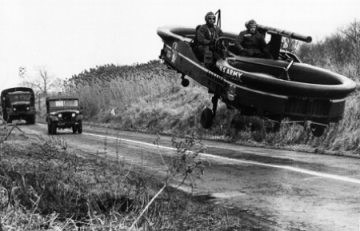
Posted on 06/16/2011 12:13:17 AM PDT by Immerito
What goes 173 mph at 10,000 feet that you ride like a motorcycle? It's either a Star Wars speeder bike, which doesn't exist, or this hoverbike invented by some Australian dude, which actually does. And you don't even need a pilot's license to fly it.
Chris Malloy's prototype hoverbike has so far not done anything but hover while tied to the ground, but that is in no way stopping its designer from making all kinds of wildly optimistic projections about its performance and availability. Expect this thing to be able to travel at upwards of 170 mph, and you can take it to 10,000 feet (or even higher, with oxygen), although you'll probably have more fun whipping around trees down low, just make sure and look out for hooligans wielding light sabers.
Since it's classified as an ultralight, you won't technically need a pilot's license, although a parachute will likely be a good idea. And for better or worse, the hoverbike is shaping up to be affordable to the point where people who really shouldn't be riding around on one of these will probably be able to: a production run of 100 a year will peg them at $40,000 each, and if 1,000 are ordered, that cost could drop to something comparable to a performance motorcycle. Yeah, having everybody commuting to work on these things would probably be a fiasco, but who cares. It's a hoverbike, man!
Hmm....I'll have to look again. Didn't notice those in the photos (but you'd think they have to be there).
I’m sorry, but I still can’t see how this thing is laterally stabilized, or how it creates forward propulsion.
Agreed.
Something like this is possible, but I’m doubting those numbers.
Besides, 10,000 feet isn’t exactly, “Hovering.”
I have ridden two prototype hovercraft, over land and water. One carried two people, and the larger one carried six. Seeing your photographs, I’ll make a few comments based on my personal experience. To rise even one foot above ground without a skirt would take some really powerful engines to levitate by brute force, and fuel consumption would be horrible. Those engines don’t look big enough either. The pictures don’t show me any convincing means to steer, and over land in particular, hovercraft might as well be sliding on oiled ice. Seat belts were an afterthought until I nearly broke some ribs.
How do you control the Hoverbike?
- To lift off into a hover, one needs to increase the thrust via a throttle grip with the right hand - exactly the same as the throttle on a motorbike
- To fly forward a combination involving an increase in thrust and the deflection of air from the front control vanes (twisting the left handle grip) will tilt the total thrust vector forward resulting in an acceleration forwards (twist back to go backwards)
- To to make the bike roll (turn) left and right, all one needs to do is push the handle bars down on the side you wish to turn (handle bars work just like a bicycle, but with an extra axis so that they rotate up and down a little) - you could lean in the appropriate direction just like a motorbike, but this is proving to be not as sensitive as one would expect or like.
- Yaw (nose left or right) is via control vanes front and rear and actuated by turning the handle bars - just like a bike
Thanks for providing a link to the FAQs. These are the answers I was looking for.
See post 44 for link to the FAQ page. It answers some questions I had about propulsion and lateral stability.
I am now envisioning somebody riding this thing and making a turn.
And spinning round and round into the oncoming semi.
Whoever makes the first test crash fright flight on that thing is one brave soul.



I went looking for the regs but did not have the patients to actually find them.
I would think that he would want his fans to contra-rotate to eliminate gyroscope tendency.
I think if he did not have his bike tethered it would spin like top.
Disclaimer: Opinions posted on Free Republic are those of the individual posters and do not necessarily represent the opinion of Free Republic or its management. All materials posted herein are protected by copyright law and the exemption for fair use of copyrighted works.